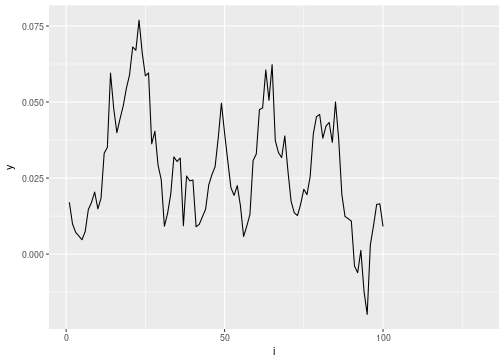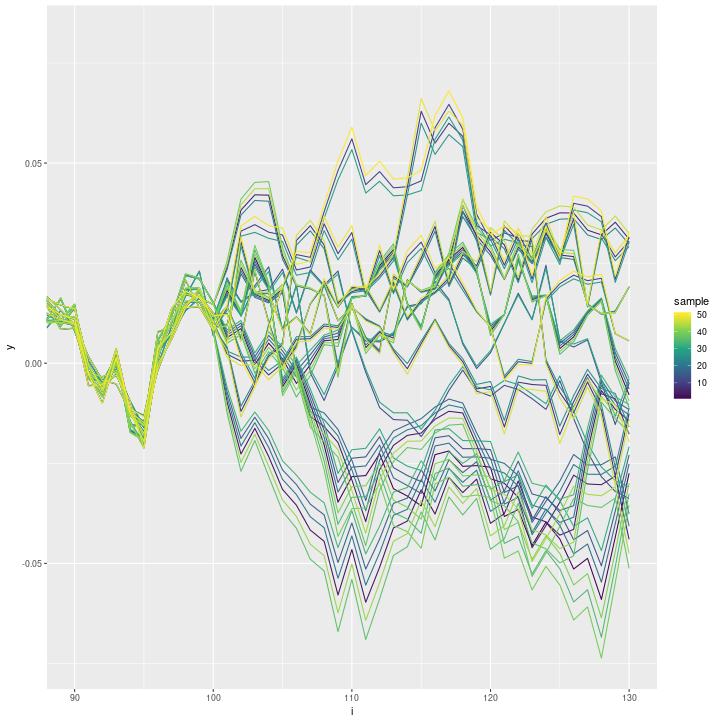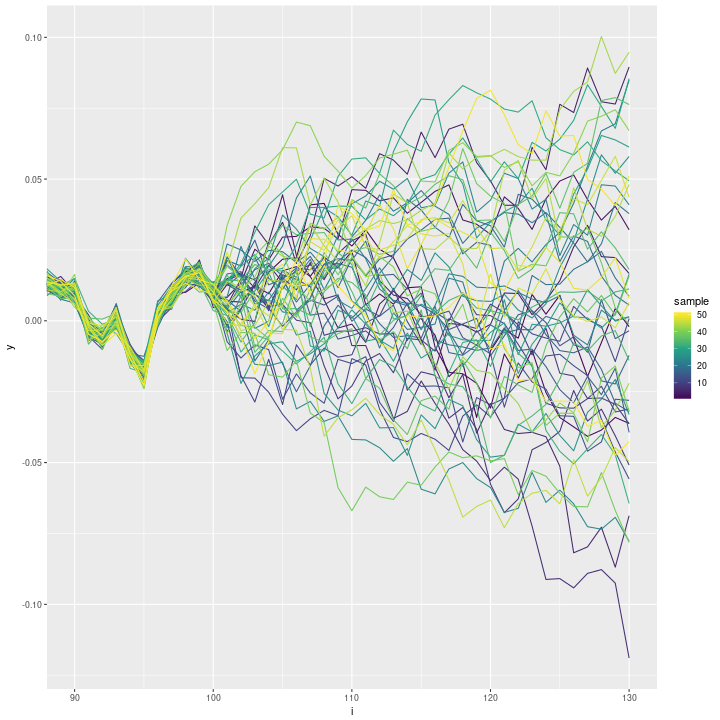Update:
The behavior described here is due to a bug in INLA which has been fixed in version 17.11.11.
(see the thread on the INLA discussion group)
Predicting a random walk
suppressPackageStartupMessages(library(INLA))
suppressPackageStartupMessages(library(stringr))
suppressPackageStartupMessages(library(tidyverse))
knitr::opts_chunk$set(
cache.path='_knitr_cache/sampler-problem/',
fig.path='figure/sampler-problem/'
)
inla.version()
##
##
## INLA version ............: 17.06.20
## INLA date ...............: Tue 20 Jun 12:36:50 JST 2017
## INLA hgid ...............: Version_17.06.20
## INLA-program hgid .......: Version_17.06.20
## Maintainers .............: Havard Rue <hrue@r-inla.org>
## : Finn Lindgren <finn.lindgren@gmail.com>
## : Daniel Simpson <dp.simpson@gmail.com>
## : Andrea Riebler <andrea.riebler@math.ntnu.no>
## : Elias Teixeira Krainski <elias.krainski@math.ntnu.no>
## : Geir-Arne Fuglstad <fulgstad@math.ntnu.no>
## Main web-page ...........: www.r-inla.org
## Download-page ...........: inla.r-inla-download.org
## Email support ...........: help@r-inla.org
## : r-inla-discussion-group@googlegroups.com
## Source-code .............: bitbucket.org/hrue/r-inla
This example is to illustrate a problem with the posterior predictive sampling algorithm in R-INLA.
set.seed(321)
n = 130
inla_data = data_frame(i = 1:n, y = cumsum(rnorm(n, 0, .01))) %>%
mutate(y = ifelse(i <= 100, y, NA_real_))
ggplot(data=inla_data, aes(x=i, y=y)) + geom_line()
## Warning: Removed 30 rows containing missing values (geom_path).

# run inla
inla_formula = y ~ f(i, model='rw1')
inla_result = inla(formula=inla_formula, data=inla_data, family='gaussian',
control.family=list(initial=12, fixed=TRUE),
control.compute=list(config=TRUE))
# posterior predictive samples
n_sampls = 50
set.seed(321)
inla_sampls = inla.posterior.sample(n=n_sampls, result=inla_result, seed=123)
# extract "Predictor" output
i_pred = str_c('Predictor:', str_pad(1:n, 3, 'left', '0'))
inla_sampls = inla_sampls %>%
setNames(1:n_sampls) %>%
map_df( ~ .x$latent[i_pred,1]) %>%
mutate(i = 1:n) %>%
gather(key='sample', value='y', -i) %>%
mutate_if(is.character, as.integer)
# plot predictive samples
ggplot(data=inla_sampls, aes(x=i, y=y, group=sample)) + geom_line(aes(colour=sample)) +
scale_colour_continuous(type='viridis') + coord_cartesian(xlim=c(90, n))

The predictive samples are highly correlated. A lot of thinning will be necessary to get pseudo-independent samples. I am wondering if there are options I could set to improve the sampler?
Avoiding the seed argument in inla.posterior.sample
The near-perfect correlation of the posterior predictive samples seems to disappear when I remove the seed argument in inla.posterior.sample:
# posterior predictive samples
n_sampls = 50
set.seed(321)
inla_sampls_noseed = inla.posterior.sample(n=n_sampls, result=inla_result)
# extract "Predictor" output
i_pred = str_c('Predictor:', str_pad(1:n, 3, 'left', '0'))
inla_sampls_noseed = inla_sampls_noseed %>%
setNames(1:n_sampls) %>%
map_df( ~ .x$latent[i_pred,1]) %>%
mutate(i = 1:n) %>%
gather(key='sample', value='y', -i) %>%
mutate_if(is.character, as.integer)
# plot predictive samples
ggplot(data=inla_sampls_noseed, aes(x=i, y=y, group=sample)) + geom_line(aes(colour=sample)) +
scale_colour_continuous(type='viridis') + coord_cartesian(xlim=c(90, n))

This looks much better.
The high correlation is probably due to a bug with how the seed argument is used internally.